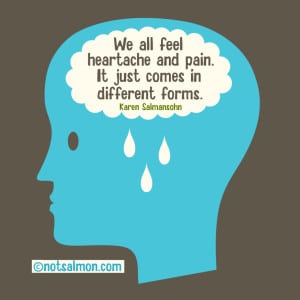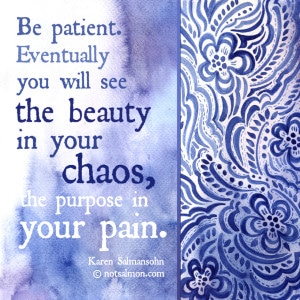
Have you been through something painful – an emotional trauma of some kind? Here’s how to heal from unbearable grief.
I’ve written about my recovery from emotional trauma ( a sexual assault) in a few places on my site – like in this particular essay – and – this essay – and in my Bounce Back Book.
I’ve confessed that it was a zig-zagging process of recovery.
For a long time I delayed my healing. I thought I was being strong, and didn’t need help.
But in reality, I was simply avoiding the “core pain truth” of what I was feeling.
Eventually I realized I was going through the emotions which Elisabeth Kübler-Ross describes in her five stages of accepting the death of a loved one – even though I had not experienced an actual death of someone.
Kübler-Ross outlined the five stages of grief as follows:
Stage #1: Denial and isolation:
“This is not happening to me.”
Stage #2: Anger:
“How dare this happen to me.”
Stage #3: Bargaining:
“Just let me get X and I won’t care about Y,” or “If this doesn’t happen, I promise to . . .”
Stage #4: Depression:
“I can’t bear to face going through this.”
Stage #5: Acceptance:
“I’m ready; I don’t want to struggle anymore.”
 Meaning?
Meaning?
As it turns out, I’m not the only one who loves to lounge around in denial during a tough time – in an attempt to avoid feeling painful emotions.
It’s a natural tendency – with its own famous stage name: “The Denial and Isolation Stage!”
In fact Joan Didion confessed being a fan of denial – in her memoir “The Year of Magical Thinking.”
She described in great detail how after the sudden death of her husband, she found herself focusing on..
- who she needed to call,
- what she needed to do,
- writing a list of things the hospital needed from her
She appeared to those around her as someone in an odd state of calm (Didion overheard a hospital social worker say: “She’s a pretty cool customer!” )
In truth, Didion was in a state of total numbness.
 Unable to face the reality of her husband’s death, Didion found herself engaging in what she describes as “magical thinking,” a conjuring of a world in which her husband might reappear.
Unable to face the reality of her husband’s death, Didion found herself engaging in what she describes as “magical thinking,” a conjuring of a world in which her husband might reappear.
Didion avoided reading John’s obituary, believing it a form of betrayal.
She told herself she must keep John’s shoes – because he would need them when he “comes back.”
Didion wondered if perhaps things would have turned out differently – had they been dining in California that night he died, rather than New York.
Eventually, however, Didion discovers what most of us discover:
When it comes to emotional pain and trauma, you can run . . . but you can’t hide.
If you’ve been through a personal tragedy, chances are that you too don’t want to accept it and let in all the painful emotions–at least for a while.
 Psychologist Sharon Wolf believes there is a “core pain” you must be ready to feel during really bad times to fully recover:
Psychologist Sharon Wolf believes there is a “core pain” you must be ready to feel during really bad times to fully recover:
“If you want to heal rightly from a crisis, be ready to tolerate more pain than you thought you could ever feel,” warns Wolf.
Thankfully, Wolf promises if you learn to sit with, feel, and tolerate this core pain, it will get smaller and smaller, until it ultimately disappears.
Or as I learned from my own travels through these stages:
Feeling means you’re dealing means you’re healing.
After numbing myself to the pain and living in denial and isolation, when my core pain finally did arrive, it was in a full-blown stage 4 depression–in the form of a crying jag that lasted for a full 2 weeks.
 During this time, I’d be walking around, feeling just fine, thank you, la-de-da de-da.
During this time, I’d be walking around, feeling just fine, thank you, la-de-da de-da.
Then suddenly, like a tidal wave–fawhomp–whoooosh!!–the floodgates would open and I was drowning.
The unbearable sadness I’d been evading finally had caught up with me and grabbed me by the throat so I couldn’t breathe.
And though I dreaded those tears and the total loss of control, I found out later this was actually a good and necessary thing.
If you’re going through emotional trauma – or any kind of challenging time – it’s essential you recognize your core pain truth.
 It’s your choice…
It’s your choice…
- Sit with the pain now
- Avoid the pain now and feel even greater pain later, thereby delaying the healing.
In the wonderful book “The Buddha and the Terrorist,” Satish Kumar writes…
“Sister, pain is part of life. By accepting it, its intensity is reduced. Do not resist it. Resistance to pain brings tension and anxiety, anxiety leads to fear. Fear of pain is worse than pain itself. This pain will pass.”
4 Tools To Heal From Unbearable Grief
Below are some tactics which helped me to move on from emotional trauma. If you are avoiding your pain and grief as I tried to do, remind yourself…
1. Fear of pain is often worse than the pain itself.
When the pain starts to seep through to your consciousness, let it come. Don’t fight those tears. If possible, give yourself specific times to grieve.
2. Keep a journal.
Track your healing process through the five stages (you may skip some stages and also regress or cycle back), but a journal will show you that progress is being made.
3. Do not numb yourself.
 Because feeling your core pain is scary, you might be tempted to seek comfort by numbing yourself–with alcohol, sleeping pills, binge eating, or other addictive substances. Be strong. Resist and persist in allowing your true pain to surface.
Because feeling your core pain is scary, you might be tempted to seek comfort by numbing yourself–with alcohol, sleeping pills, binge eating, or other addictive substances. Be strong. Resist and persist in allowing your true pain to surface.
- Explore my bestselling video course, Stop Emotional Eating, to help retrain your brain to crave healthier foods and more self loving habits.
4. Remember: You are an unfinished self in progress.
When you experience life’s challenges, and eventually overcome your pain, you can wind up revealing new emotional depths and helpful perspectives you didn’t know you were capable of having.
Get More Bounce Back Tools
Think happier. Think calmer.
Think about subscribing for free weekly tools here.
No SPAM, ever! Read the Privacy Policy for more information.
One last step!
Please go to your inbox and click the confirmation link we just emailed you so you can start to get your free weekly NotSalmon Happiness Tools! Plus, you’ll immediately receive a chunklette of Karen’s bestselling Bounce Back Book!



 Meaning?
Meaning? Unable to face the reality of her husband’s death, Didion found herself engaging in what she describes as “magical thinking,” a conjuring of a world in which her husband might reappear.
Unable to face the reality of her husband’s death, Didion found herself engaging in what she describes as “magical thinking,” a conjuring of a world in which her husband might reappear. Psychologist Sharon Wolf believes there is a “core pain” you must be ready to feel during really bad times to fully recover:
Psychologist Sharon Wolf believes there is a “core pain” you must be ready to feel during really bad times to fully recover: During this time, I’d be walking around, feeling just fine, thank you, la-de-da de-da.
During this time, I’d be walking around, feeling just fine, thank you, la-de-da de-da. It’s your choice…
It’s your choice… Because feeling your core pain is scary, you might be tempted to seek comfort by numbing yourself–with alcohol, sleeping pills,
Because feeling your core pain is scary, you might be tempted to seek comfort by numbing yourself–with alcohol, sleeping pills, 